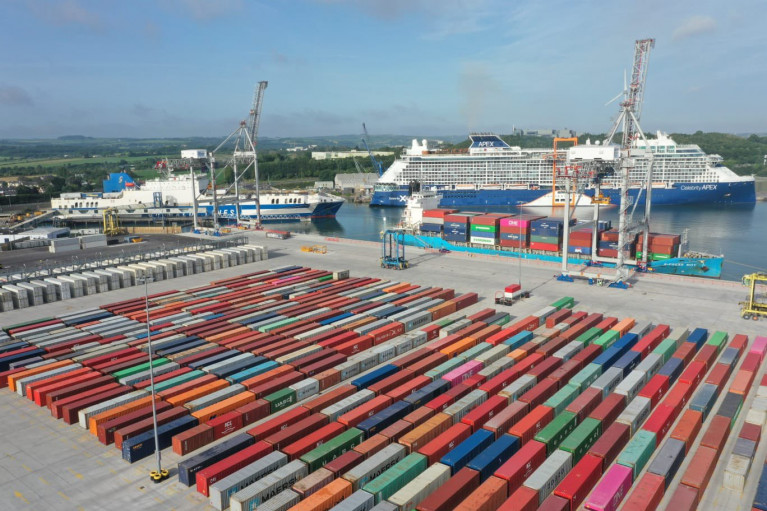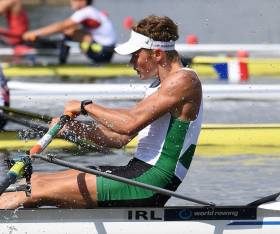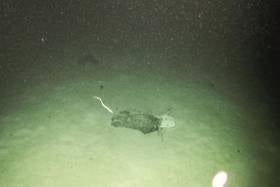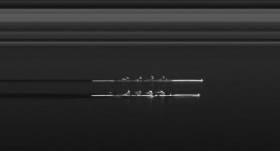Displaying items by tag: UCC
Marine Notice: Cetacean Acoustic Monitoring at Arklow Bank and Gorey
The Department of Transport has been advised by University College Cork (UCC) that it intends to deploy hydrophones east of the Arklow Bank at four locations, and southwards to 15km off the bank and east of Gorey and Blackwater.
This marine science research aims to describe seasonal and diurnal occurrence of the cetaceans (the order of marine wildlife that comprises whales, dolphins and porpoise) present in the areas.
UCC plans to deploy four moorings with attached hydrophones on the seabed between the dates of Monday 5 and Saturday 17 February, subject to operational and weather constraints. The moorings will be fully recovered after three to four months for maintenance and then redeployed.
The hydrophones will be deployed in four locations in a latitudinal gradient, from east of the turbines at the Arklow Bank to 10km south of the bank, east of Gorey and Blackwater, Co Wexford.
A single vessel will be used for deploy the hydrophones: the Sharpshooter (callsign EI5069). Deployment operations will be conducted during the hours of daylight, during favourable weather conditions.
Throughout operations, the vessel will be displaying the appropriate lights and shapes as required under the COLREGS Rule 27(b). As Sharpshooter will be deploying survey equipment and moorings, the vessel will be restricted in its ability to manoeuvre, therefore all other vessels are requested to leave a wide berth.
Coordinates and a map of the survey areas as well as contact details can be found in Marine Notice No 05 of 2024, attached below.
ESB and Shannon Foynes Port Announce Support for Floating Offshore Wind Research at UCC
The ESB and Shannon Foynes Port have announced a funding collaboration for a €250k study at MaREI — the SFI Research Centre for Energy, Climate and Marine at University College Cork (UCC) — in the latest step towards helping Ireland to deliver floating offshore wind (FLOW) projects in the future.
Starting this month, the focus of the research will be to examine the requirements and identify potential sites for wet storage, which is the temporary offshore storage of floating offshore wind turbines in suitable areas prior to installation.
This is a key requirement for facilitating floating offshore wind, which will be a fundamental technology in Ireland reaching its offshore renewable targets.
Research will take place over two phases. The first phase will consist of understanding the key conditions and constraints associated with the development and identification of suitable wet storage sites, while phase two will focus on the technical challenges of designing sites in terms of the optimum layout and mooring configuration.
The aim of the study is to identify and inform considerations for the future FLOW industry that are required at an economic, environmental, societal and policy level in Ireland and also, to set a benchmark for best international practice through close academic and industry collaboration.
Ronan O’Flynn, ESB programme director for Green Atlantic @ Moneypoint said: “We understand the importance that floating offshore wind projects are going to play in both Ireland achieving its ambitious renewable energy targets and ESB delivering on our commitment to reach net zero by 2040.
“Research such as this, carried out by our partners MaREI and supported by Shannon Foynes Port, will help the entire industry to better understand what is required for crucial wet storage facilities that will allow floating offshore wind projects to be delivered at scale.”
‘This project will be an important enabler for the emerging floating wind energy sector in Ireland’
Pat Keating, CEO at Shannon Foynes Port said: “Our partnership with the ESB on funding this research will help underpin understanding in the key area of wet storage, in which [the] Shannon Estuary will be a major provider of as we go about harvesting the unprecedented opportunity for not just our region and State arising from floating offshore wind.
“Because of the estuary’s existing deepwater ports at Foynes and Moneypoint, wet storage space and available land for large-scale industrial development, we are one of few locations in Europe that can manufacture floating turbines at the scale necessary for commercialisation.”
Dr Jimmy Murphy, funded investigator in MaREI and senior lecturer in the School of Engineering in UCC, said: “This project will be an important enabler for the emerging floating wind energy sector in Ireland and will allow strategic planning decisions to be made related to the efficient deployment of floating windfarms.
“MaREI has a track record of research and development in floating wind and welcomes this collaboration with ESB and Shannon Foynes Port to address the challenge of identifying potential wet storage locations and optimising design layout.”
Ireland’s offshore wind energy potential arising from our Atlantic seaboard winds is among Europe’s leading renewable energy opportunities, the partners suggest.
With a maritime area more than seven times the size of its landmass, ideal wind conditions and strategic location on the Atlantic Ocean's edge, floating offshore wind generation has the potential to deliver up to 30 gigawatts of energy by 2050 — six times more than current domestic electricity demand.
MaREI will provide the research expertise along with the various tools required for the study which is aligned with their core research principles. ESB and Shannon Foynes Port will provide funding support and industry knowledge for the study which is in line with ESB’s Net Zero by 2040 strategy and Shannon Foynes Port’s Vision 2041 masterplan.
Marine Notice: Deployment of Benthic Sensors Between Seven Heads and the Old Head of Kinsale
The Department of Transport has been advised by the School of Biological, Earth and Environmental Sciences at University College Cork that on on Tuesday 12 June it deployed 12 benthic sensors between the Seven Heads and the Old Head of Kinsale in West Cork.
These sensors are being used in scientific research which aims to track skate using acoustic tracking equipment.
The benthic sensors will be deployed for 12 months. Each sensor consists of a mooring weight and an acoustic sensor for tracking tagged skate in the area. None have surface markers.
A map and coordinates of the sensor positions as well as contact details can be found in Marine Notice No 39 of 2023, attached below.
The impact of Brexit across many sectors in the South West, in particular in agriculture, finance, and industry is revealed in a new report that shows Cork’s long history of trade with Europe has helped to cushion the worst effects of Brexit for the city and the wider region.
The report, ‘Cork and the Brexit Effect’, published by University College Cork, looked at Brexit’s consequences for the Cork region.
It was developed with local business, the tourism sector, higher education, and arts and culture stakeholders across Cork.
The report noted that relations and links between Cork, the North, and the UK have been affected by the fallout from Brexit.
It showed, however, that while visits to the Republic of Ireland from Britain and the North fell following Brexit, the Cork region was comparatively less affected by shifting tourist numbers than other parts of Ireland.
The report also suggests that Brexit has presented Cork with new opportunities and highlights how, since Brexit, the Port of Cork has seen its number of direct shipping routes to continental Europe increase as producers look to avoid the UK land-bridge.
EchoLive has more on the report that also examines aspects on the EU’s second-largest English-speaking city
UCC Researchers Part of EU Project to Tap Oceans for New Medicines
New antibiotics in the world’s oceans and the curative properties of marine animals like sponges will be explored in a European project involving researchers at University College Cork (UCC).
The EU has awarded a total of €7.5 million under its Horizon 2020 programme to the research into the largely unknown potential of the world’s oceans in protecting people, animals and crops from disease.
The Marine Biodiversity as Sustainable Resource of Disease-Suppressive Microbes and Bioprotectants for Aquaculture and Crop Diseases project, as it is officially known, has been given the name “Marbles”.
The research team will look specifically for new antibiotics and anti-fungals as well as microbes that can serve as “bio-protectants” in agriculture and aquaculture.
Synthetic chemicals currently used in pharmaceutical, agriculture and aquaculture have a devastating impact on marine life and this research is looking for sustainable solutions, according to the UCC research team.
The project will assess the potential of microorganisms derived from marine sponges, microalgae and fish for disease suppression.
They explain that “disease-suppressive” microorganisms will be drawn from "microbiomes", the complex collection of microorganisms that live in and around their marine hosts.
The world’s growing population and the current climate and biodiversity crises are driving the need to harness new compounds with pharmaceutical and nutritional applications sustainably, the UCC team says.
Prof Alan Dobson and Dr David Clarke from the UCC School of Microbiology and the Environmental Research Institute said that they were particularly excited about collaborating with the other 13 European partners from both academia and industry.
One project they hope to focus on involves isolating and genetically characterising disease suppressive microorganisms from the microbiome of Atlantic salmon.
These may then be generated into cocktails of microbial consortia, which could then be used either within fish feed as probiotics, or applied externally to boost the skin’s immune response in the salmon, they state.
This will improve disease control and overall fish health, and should decrease the dependency of using antibiotics in fish aquaculture systems while also reducing the potential spread of antimicrobial resistance in aquatic ecosystems, they state.
The use of drones could play a key role in sustainable coastal fisheries in Ireland, according to a new study.
As the Irish Examiner reports, researchers at University College Cork (UCC) evaluated a wide range of applications for drones on the Irish coast, and highlighted a number of potential important uses.
These run from monitoring illegal fishing activity to studying pollution, surveying areas at risk of erosion or even identifying new viruses transmitting among marine wildlife — as well as supporting some of the UN’s Sustainable Development Goals.
Drone patrols have already been cited as more important than ever for the protection of Ireland’s inland fisheries following an increase in illegal fishing and angling activities recorded last year, as previously reported on Afloat.ie.
“The speed of development in drone technology means it can be difficult for many people to appreciate its current potential,” UCC’s Dr Samuel Hayes said.
The Irish Examiner has more on the story HERE.
UCC Confirms its Marine Life Survey Staff Were on Light Aircraft Which Crash Landed on Wexford Beach
University College Cork (UCC) says it is providing support to its staff who were passengers on the aircraft that was forced to make an emergency landing at Carne beach in Co Wexford on Thursday.
The staff were conducting marine life surveys in Irish offshore waters as part of the ObSERVE II project, UCC has confirmed.
An Air Accident Investigation Unit (AAIU) inquiry has been initiated into the light aircraft crash which occurred at about 5.10 pm on September 23rd.
The €4.5 million ObSERVE programme has been conducting aerial surveys of almost 500,000km2 of Ireland’s maritime area.
It is being funded by several Government departments as part of planning for offshore renewable and other marine activities which could have an impact on sensitive marine ecosystems.
The UCC team is led by Dr Mark Jessopp and Professor Emer Rogan from the School of Biological, Earth and Environmental Sciences, with partners from Action Air, France, Wageningen University and Research in the Netherlands and Duke University in the US.
The four occupants of the aircraft - two men aged in their 20s and 50s and two women both aged in their 30s - sustained non life-threatening injuries in the incident.
The wreckage of the French-registered Vulcanair P68 twin-engined, four-seater aircraft has been recovered by the AAIU for delivery to Gormanston, Co Meath for a full examination.
AAIU chief Jurgen Whyte told RTÉ News that it was not yet clear if it was an engine problem or control issue that led to the emergency landing, and also credited the pilot for his successful manoeuvre.
The pilot had issued a “Mayday” after it got into trouble off the Wexford coast, and had to transit a nearby wind farm to approach the beach.
The sudden “deceleration” in approaching the beach would have resulted in injury, Whyte explained.
An eye witness, Niall Hore, has told the Padraig Byrne of The Wexford People that the four occupants were very fortunate and paid tribute to the pilot.
Hore, who had gone to Carne beach for some sea angling, said he and several Northern Irish anglers witnessed the incident.
“We ran down and two people were out of the plane and were shouting for us to call 112. The two people in the back of the plane were able to get out and had dragged out the pilot and co-pilot and they were propped up against the plane,” Hore said.
"The plane was very bent up at the front and I knew that the pilots’ legs must have been in a bad way,” he said.
“We just tried to keep them talking to make sure they were OK. We asked them where they came from and they said they took off from Waterford and that they were on their last run doing marine surveys in the area,” he said.
"One of the women was pretty bad and was covered in blood and not saying much, so we tried to talk to her to make sure she was OK. As it turned out, one of the crew was from Northern Ireland and was from the same area as the two other fishermen who were on the beach, he added.
“He did very well to get it down just at the shore,” Niall Hore said.
“I’m just glad he didn’t land further out in the water because the current is unreal there and it would have been very hard to get to them. It definitely wasn’t an easy thing for him to do. I’m just really glad that everyone is going to be alright, “he said.
Read more in The Wexford People here
Sutton and Legresley Win Time Trial for Cork Sculling Ladder
#Rowing: Hugh Sutton of UCC Rowing Club was the overall winner of the 48th Cork Sculling Ladder time trial, which was run on calm water and on an outgoing tide at the Marina on the River Lee on Sunday. Sutton covered the 1800 metres in seven minutes and 3.4 seconds. Jessica Legresley of Shandon Boat Club won the women’s trial in 7:57.5.
Two previous winners of the the ladder, Jack Dorney and Andy Harrington, set a time of 6:42.1 as they won the first coxless pairs time trial. Amy Mason and Grace Collins won the the women’s pairs time trial in 7:36.1.
The event, which was sponsored by Argos Fire, had a big entry. The oldest competitor on the day was 83-year-old Seamus Quane of Shandon Boat Club.
The sculling and coxless pairs ladders continue with two-boat racing until March 2020.
Marine scientists from University College Cork have discovered plastic at the bottom of a deep submarine canyon while investigating cold-water coral habitats.
UCC’s Marine Geology Research Group has been investigating cold-water coral habitats in the Porcupine Bank Canyon, some 320km due west of Dingle, on a research expedition led by UCC’s Dr Aaron Lim on board the Marine Institute’s RV Celtic Explorer.
The team had recovered eight novel monitoring stations, called ‘landers’, worth €450,000 and deployed between 700m and 2500m water depth by the Marine Institute’s Remotely Operated Vehicle (ROV) Holland 1 earlier this summer.
The monitoring stations record the speed, temperatures and direction of the currents around these habitats as well as trapping samples of the food, sediments and microplastic being deposited around the corals, to understand conditions and how the corals are coping with changing oceans.
The researchers found plastic in the bottom of one canyon at 2,125m water depth — as deep as ten Eiffel Towers stacked on top of one another.
The reach of human plastic waste is now confirmed as this deep, even 320km offshore.
“It’s always sad to see plastic rubbish in these otherwise pristine habitats. It’s quite incredible that our plastic waste can get this far out and so deep in the oceans,” said Professor Andy Wheeler of UCC, who has pioneered research on cold-water coral mounds offshore of Ireland over the past 20 years.
“I don’t think people think about this when that dump their rubbish. We’re also trying to see if microplastics are being fed to the corals from above. We’ve just got the samples; let’s hope we're wrong.”
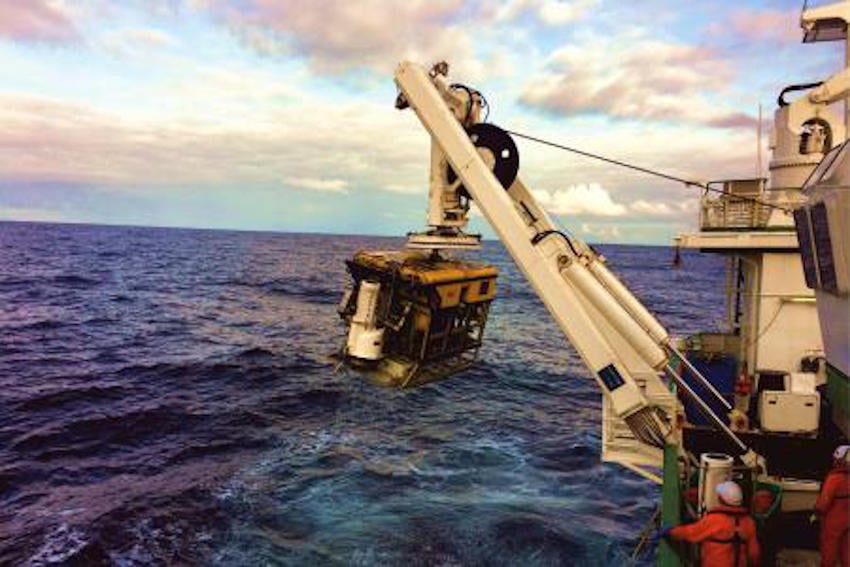 ROV Holland 1 recovering one of the monitoring stations | Photo: UCC
ROV Holland 1 recovering one of the monitoring stations | Photo: UCC
The Porcupine Bank Canyon is teeming with a whole range of cold-water coral habitats, just on Ireland’s doorstep, says Dr Lim.
“The environment is much more dynamic than we thought, with two of the monitoring stations knocked over by the currents; food supply for the coral is variable but the corals are doing okay.
“Some of these habitats have existed for millions of years and have grown so large they resemble hills made of coral, called coral mounds.
“This is the first time eight of these monitoring stations have been deployed and collected using the ROV Holland 1. It will provide scientists with an insight into the processes affecting these cold-water coral habitats, food sources and the impact of microplastics.”
Dr Lim said Ireland’s cold-water coral reefs are found in the cold, dark ocean at water depths of 600m to 1,000m along our continental margin.
“Not only is this expedition vital for understanding these habitats and our impact upon them, it also acts as a baseline to start monitoring how our deep-water habitats here are changing,” he added.
The team has a research agenda which will see them return to the canyon and other habitats alike for a number of years, to monitor the changes in the environment around these habitats. The monitoring stations will be brought back to UCC for detailed analyses.
This research survey is carried out with the support of the Marine Institute, funded under the Marine Research Programme 2014-2020 by the Government to support and promote the Atlantic Ocean Research Alliance, which facilitates common research and knowledge exchange for us to provide healthy, resilient oceans for our future generations.
The survey has also received funding from Science Foundation Ireland, Geological Survey Ireland and UCC.
Cork Clubs on a Run at Irish Championships
#Rowing: Cork clubs had a set of good results in the first session of Sunday finals at the Irish Rowing Championships at the National Rowing Centre.
Cork Boat Club's junior women's pair started the ball rolling, while Skibbereen then took their second title of Championships as Aodhan Burns proved a strong winner of the lightweight single sculls.
Margaret Cremen of UCC had a huge win in the lightweight single sculls, and Lee added the junior men's double to the junior quadruple title they had won on Saturday.
The tighest finish came in the men's club coxed four. NUIG made a tremendous effort to catch St Michael's of Limerick but they fell short by just .329 of a second.
Commercial of Dublin and Fermanagh's Enniskillen Royal Boat Club are having a good reatta. Enniskillen won the men's intermediate pair, while Commercial won the womens intermediate coxed four.


























